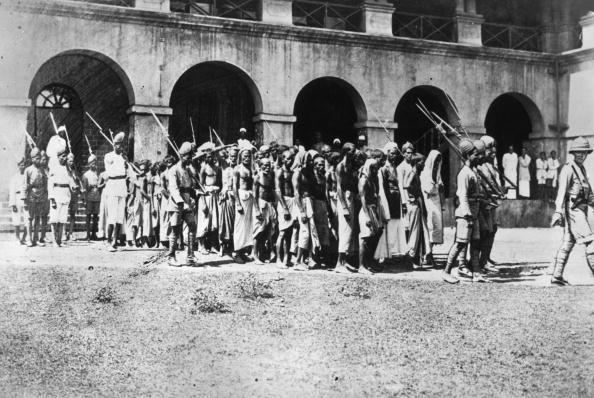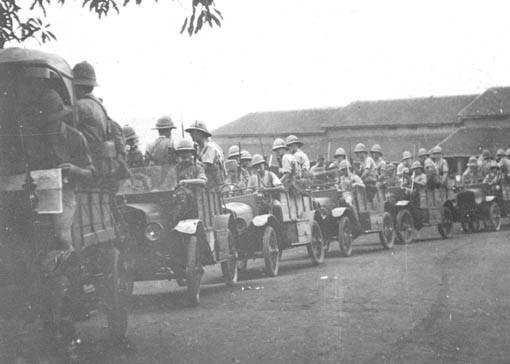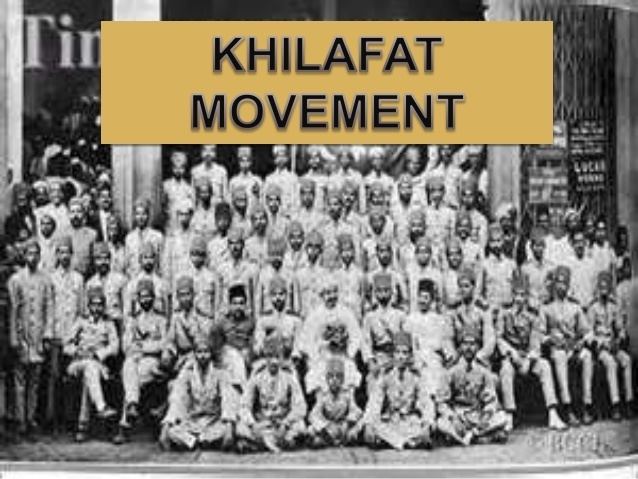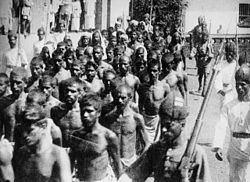Date 1921 | Result Rebellion suppressed | |
 | ||
Thomas T. S. Hitchcock, A. S. P. Amu Ali Musliyar, Variankunnath Kunjahammad Haji, Sithi Koya Thangal, Chembrassery Thangal, K. Moiteenkutti Haji, Konnara Thangal, Abdu H Hin.British forces43 troops killed, 126 troops wounded Similar Third Anglo‑Mysore War, Second Anglo‑Mysore War, Fourth Anglo‑Mysore War, Invasion of Ceylon, First Anglo‑Mysore War | ||
The Malabar Uprising (also known as the "Moplah Rebellion", "മാപ്പിള ലഹള" Māppila Lahaḷa in Malayalam) was an armed uprising in 1921 against British authority and Hindus in the Malabar region of Southern India by Mappila Muslims and the culmination of a series of Mappila revolts that recurred throughout the 19th century and early 20th century. The 1921 rebellion began as a reaction against a heavy-handed crackdown on the Khilafat Movement by the British authorities in the Eranad and Valluvanad taluks of Malabar. In the initial stages, a number of minor clashes took place between Khilafat volunteers and the police, but the violence soon spread across the region. The Mappilas attacked and took control of police stations, British government offices, courts and government treasuries. The Moplah Rebellion that started as a fight against the British ended up as large scale massacre and persecution of Hindus. In the later stages of the uprising, Mappilas committed several atrocities against The Hindu community, who they accused of helping the police to suppress their rebellion. Annie Besant reported that Muslim Mappilas forcibly converted many Hindus and killed or drove away all Hindus who would not apostatise, totalling to one lakh (100,000).
Contents
- Land ownership in Malabar
- Jenmi
- Kanikkaran Nairs
- Verumpattakkaran Mappilas
- Land Reforms and Mappila Outbreaks 18361921
- Indian national movement
- Rebellion and response
- Reactions
- Statistics
- Popular culture
- Monuments
- References

The British Government put down the rebellion with an iron fist, British and Gurkha regiments were sent to the area and martial law imposed. One of the most noteworthy events during the suppression later came to be known as the "Wagon tragedy", in which 61 out of a total of 90 Mappila prisoners destined for the Central Prison in Podanur suffocated to death in a closed railway goods wagon.

For six months from August 1921, the rebellion extended over 2,000 square miles (5,200 km2) – some 40% of the South Malabar region of the Madras Presidency. An estimated 10,000 people lost their lives, although official figures put the numbers at 2337 rebels killed, 1652 injured and 45,404 imprisoned. Unofficial estimates put the number imprisoned at almost 50,000 of whom 20,000 were deported, mainly to the penal colony in the Andaman Islands, while around 10,000 went missing. The most prominent leaders of the rebellion were Variankunnath Kunjahammad Haji, Sithi Koya Thangal and Ali Musliyar. Estimates of the number of forced religious conversions range from 180 to 2500; 678 of the 50,000 rebels were charged with this crime.

Contemporary British administrators and modern historians differ markedly in their assessment of the incident, debating whether the revolts were triggered off by religious fanaticism or agrarian grievances. At the time, the Indian National Congress repudiated the movement and it remained isolated from the wider nationalist movement. However, contemporary Indian evaluations now view the rebellion as a national upheaval against British authority and the most important event concerning the political movement in Malabar during the period.

In its magnitude and extent, it was an unprecedented popular upheaval, the likes of which has not been seen in Kerala before or since. While the Mappilas were in the vanguard of the movement and bore the brunt of the struggle, several non-Mappila leaders actively sympathised with the rebels' cause, giving the uprising the character of a national upheaval. In 1971, the Government of Kerala officially recognised the active participants in the events as "freedom fighters".

Land ownership in Malabar

Malabar's agricultural system was historically based on a hierarchy of privileges, rights and obligations for all principal social groups in what British administrator William Logan sometimes referred to as the "Father of Tenancy Legislation" in Malabar, describing it as a system of 'corporate unity’ or joint proprietorship of each of the principal land right holders:
Jenmi
The Jenmi, consisting mainly of the Nambudiri Brahmins and Nambiar chieftains, were the highest level of the hierarchy, and a class of people given hereditary land grants by the Naduvazhis or rulers'. The rights conveyed by this janmam were not a freehold in the European sense, but an office of dignity. Owing to their ritual status as priests ( Nambudris ), the jenmis could neither cultivate nor supervise the land but would instead provide a grant of kanam to an individual from the Kanikkaran ethnic group in return for a fixed share of the crops produced. Typically, a Jenmi would have a large number of kanikkaran under him.
Kanikkaran (Nairs)
The Kanikkaran, mostly members of the Nair community, were responsible for the security and supervision of the land and distribution of respective shares of produce. Like the jenmi, the kanikkaran was also a part-proprietor of the soil to the extent that one-third of the net produce was his. Each kanikkaran typically had a number of verumpattakkaran under him.
Verumpattakkaran (Mappilas)
the Verumpattakkaran, generally Thiyya and Mappila classes, cultivated the land but were also its part-proprietors. These classes were given a Verum Pattam (Simple Lease) of the land that was typically valid for one year. According to custom, they were also entitled to one-third or an equal share of the net produce. The net produce of the land was the share left over after providing for the cherujanmakkar or all the other birthright holders such as the village carpenter, the goldsmith and agricultural labourers who helped to gather, prepare and store produce. The system ensured that no jenmi could evict tenants under him except for non-payment of rent. This land tenure system was generally referred to as the janmi-kana-maryada (customary practices).
Land Reforms and Mappila Outbreaks (1836–1921)
During the Mysorean interlude (1788–1792), when the Muslim invasion of malabar led to widespread atrocities on The Hindu population, the landowners were forced to take refuge in neighbouring states. The tenants and the Nair armymen, who could not escape were forcibly converted into Islam as described in William Logan's Malabar Manual. Thus, the Malabar government under suzerainty of Tipu's Islamic Sultanate, having driven out the Hindu Landlords, reached accord with the Muslim Kanakkars. A new system of land revenue was introduced for the first time in the region's history with the government share fixed on the basis of actual produce from the land.
However, within 5 years, British took over Malabar defeating and ending Tipu's reign over the region. This allowed the Hindu landlords to return to their homes and regain the lands lost during the Islamic aggression, with the help of the British government and its duly constituted law courts. The British superimposed several Anglo-Roman juridical concepts, such as that of absolute property rights, upon the existing legal system of Malabar. Up until then, such rights had been unknown in the region and as a result all land became the private property of the jenmis. This legal recognition gave them the right to evict tenants, which was in turn enforced through the British civil courts. In the words of William Logan:
The (British) authorities, recognised the Janmi as absolute owner of his holding, and therefore free to take as big a share of the produce of the soil as he could get out of the classes beneath him... (Gradually) The British Courts backed up by Police and Magistrates and troops and big guns made the Janmi's independence complete. The hard terms thus imposed on the Kanakkaran had, of course, the effect of hardening the terms imposed by the Kanakkaran on those below him, the Verumpattakkar. The one-third of the net produce to which the Verumpattakkaran was customarily entitled, was more and more encroached upon as the terms imposed on the Kanakkaran became harder and harder. (Government of Madras. 1882, Vol. I: xvii, xxxi–ii)
As conditions worsened, rents rose to as high as 75–80% of net produce, leaving the verumpattakkar cultivators largely "only straw". This caused great resentment among the Mappilas, who in the words of Logan were "labouring late and early to provide a sufficiency of food for their wives and children". General resentment amongst the Muslim population led to a long series of violent outbreaks beginning in 1836. These always involved the murder of Hindus, an act which the disgruntled Mappilas regarded as religiously meritorious and as part of their larger obligation to establish an Islamic state. In 1921, for instance, the stated aim was not to oust the Janmi system, but to establish an Islamic nation in Malabar. The British administration referred to the outbreaks as "Moplah outrages", but modern historians tend to treat them as religious outbreaks or expressions of agrarian discontent. The massacre of Hindus and widespread sexual violence in 1921–22 sustained this tradition of violence in Malabar but with one crucial difference: this time it had also a political ideology and a formal organisation.
Indian national movement
The nationalist movement came relatively late to 'sleeping Malabar'. Although a District Congress Committee was formed in 1908, it was the first Malabar District Conference of the All India Home Rule League under Annie Besant in 1916 that marked the rise of nationalist politics in the region. At the time, the League was largely dominated by Tamil Brahmin and educated lawyers from the Nair community. The conference opened with an oath of loyalty to the King and resolved to begin educating the people to create public opinion in favour of a system of Self-Government in India.
In 1920, the District Congress Committee was reorganised as the Kerala Provincial Congress Committee at the fifth District Conference held at Manjeri in Ernad taluk. A conflict arose at the conference between two factions, one led by Annie Besant and supported by the landlords and the other by local leaders from the region with the backing of Mappila peasants. Huge numbers of the latter group attended the conference and a resolution demanding tenancy reforms was passed, despite the opposition of the landlords present.
Rebellion and response
On 20 August 1921, the police attempted to arrest Vadakkevittil Muhammed, the secretary of the Khilafat Committee of Ernad at Pookkottur, alleging that he stolen the pistol of a Hindu Thirumulpad from a Kovilakam (manor) in Nilambur. A crowd of 2,000 Mappilas from the neighbourhood foiled the attempt, but on the following day a squad of police arrested a number of Khilafat volunteers and seized records at the Mambaram mosque in Tirurangadi, leading to rumours that the building had been desecrated. A large crowd of Mappilas converged on Tirurangadi and besieged the local police station. The police opened fire on the crowd, triggering a furious reaction which soon engulfed the Eranad and Valluvanad taluks along with neighbouring areas and continued for over two months.
Following the mosque incident, the rebels attacked and seized police stations, government treasuries, and entered the courts and registry offices where they destroyed records. Some even climbed into the judges' seats and proclaimed the advent of swaraj (self-rule). The rebellion soon spread to the neighbouring areas of Malappuram, Manjeri, Perinthalmanna, Pandikkad and Tirur under principle leaders Variankunnath Kunjahammad Haji, Seethi Koya Thangal of Kumaranpathor and Ali Musliyar. By 28 August 1921, British administration had virtually come to an end in Malappuram, Tirurangadi, Manjeri, and Perinthalmanna, which then fell into the hands of the rebels who established complete domination over the Eranad and Valluvanad Taluks. On 24 August 1921, Variankunnath Kunjahammad Haji took over command of the rebellion from Ali Musliyar. Public proclamations were issued by Variyankunnath and Seethi that no harm should come to Hindus and that those Mappilas who resorted to looting would receive exemplary punishments.
During the initial stages of the rebellion, the British military and police were forced to withdraw from these areas but by the end of August several contingents of British troops and Gurkha arrived. Clashes with the rebels followed, one of the most notable encounters taking place at Pookkottur (often referred by the Moplahs as Pookkottur War), in which British troops sustained heavy casualties and had to retreat to safety.
During the early phase of the rebellion, the targets were primarily the jenmis and the British Government. Crimes committed by some of the rebels were accepted by leaders.Very quickly it turned out aimed at Hindus irrepective of their caste. After the proclamation of Martial law and the arrival of the British army, when some members of the Hindu community were enlisted by the army to provide information on the rebels. Once they had eliminated the minimal presence of the government, the Moplahs turned their full attention to attacking Hindus while Ernad and Valluvanad were declared Khilafat kingdoms.
By the end of 1921, the situation was brought under control. The British administration raised a special quasi-military (or Armed Police) battalion, the Malabar Special Police (MSP), initially consisting of non-Muslims and trained by the British Indian Army. The MSP then attacked the rioters and eventually subdued them.
Reactions
Citing narratives available to him regarding the actions of the Mappilas during the rebellion, C. Sankaran Nair wrote a strongly worded criticism of Gandhi and his support for the Khilafat Movement, accusing him of being an anarchist. He was highly critical of the "sheer brutality" of the atrocities committed on women during the rebellion, finding them "horrible and unmentionable". In particular, he referred to a resolution under the Zamorin Raja of the time and an appeal by the Rani of Nilambur. He further wrote:
"The horrid tragedy continued for months. Thousands of Mahomedans killed, and wounded by troops, thousands of Hindus butchered, women subjected to shameful indignities, thousands forcibly converted, persons flayed alive, entire families burnt alive, women it is said hundreds throwing themselves into wells to avoid dishonour, violence and terrorism threatening death standing in the way of reversion to their own religion. This is what Malabar in particular owes to the Khilafat agitation, to Gandhi and his Hindu friends."
A conference held at Calicut presided over by the Zamorin of Calicut, the Ruler of Malabar issued a resolution:
"That the conference views with indignation and sorrow the attempts made at various quarters by interested parties to ignore or minimise the crimes committed by the rebels such as: brutally dishonouring women, flaying people alive, wholesale slaughter of men, women and children, burning alive entire families, forcibly converting people in thousands and slaying those who refused to get converted, throwing half dead people into wells and leaving the victims to struggle for escape till finally released from their suffering by death, burning a great many and looting practically all Hindu and Christian houses in the disturbed areas in which even Moplah women and children took part and robbed women of even the garments on their bodies, in short reducing the whole non-Muslim population to abject destitution, cruelly insulting the religious sentiments of the Hindus by desecrating and destroying numerous temples in the disturbed areas, killing cows within the temple precincts putting their entrails on the holy image and hanging skulls on the walls and the roofs."
Statistics
According to official records, the British government lost 43 troops with 126 wounded, while 2337 rebels were killed, another 1652 injured and 45,404 imprisoned. Unofficial estimates put the number at 10,000 Mappilas killed and 50,000 imprisoned, of who 20,000 were deported (mainly to the penal colony in the Andaman Islands) while around 10,000 went missing. The number of civilian casualties is estimated at between 500 and 600.
Official estimates of forced religious conversions were put at 180, but unofficial estimates suggest a figure of between 1000 and 1500. Arya Samaj sources reported a number of 1766, adding that the total might exceed 2500, the highest estimate made. Out of a total of almost 50,000 Mappilas involved in the rebellion, 678 were charged with the crime of forced religious conversion, not all of who were guilty of involvement.
Within five years subsequent to the conflict the agricultural output was averaging slightly more than prior to it. Qureshi has said that, "In short, contrary to popular belief, Malabar did not suffer a massive devastation, and even if it did the recovery was miraculous."
Popular culture
Renowned author Uroob's masterpiece novel Sundarikalum Sundaranmarum (The Beautiful and the Handsome) is set in the backdrops of Malabar Rebellion. The novel has about thirty characters belonging to three generations of eight families belonging to Malabar during the end of the Second World War. Sundarikalum Sundaranmarum won the Kendra Sahitya Akademi Award, India's most prestigious literary award, in 1960. It also received the Asan Centenary Award in 1973, a special award given by the Kerala Sahitya Akademi for the most outstanding work since Independence.
The 1988 Malayalam language film 1921 or Ayirathi Thollayirathi Irupathonnu (English title: "Nineteen Twenty One") directed by I. V. Sasi and written by T. Damodaran, depicts the events of the rebellion. The film stars Mammootty as Khadir, a retired Mappila soldier, alongside Madhu as Ali Musliyar. The film won the Kerala State Film Award for Best Film with Popular Appeal and Aesthetic Value in the same year.
The rebellion also spawned a large number of Mappila Songs. Many of these describe the events surrounding the Khilafat movement in Malabar and offer a view of conditions in the area at the time. Ahmed Kutty composed the Malabar Lahala enna Khilafat Patt in 1925, which describes the events of the rebellion. Many of rebel prisoners such as Tannirkode Ossankoya composed songs in their letters to relatives.
Monuments
The Officers and Men from the Dorset Regiment, who lost their lives while taking part in the suppression of the revolt are commemorated in a brass tablet at the St. Mark's Cathedral, Bangalore.
The Variyankunnath Kunjahammad Haji memorial town hall in Malappuram Municipality is named after the leader of the rebellion while the Tirur Wagon Tragedy memorial townhall commemorates the eponymous incident. The Pookkottur war memorial gate is dedicated to those killed in the Pookkottur battle.
Along with these monuments, abandoned graves of British officers who lost their lives during the Rebellion can be seen in Malabar. This include that of Private F. M. Eley, Private H. C. Hutchings (both died of wounds received in action against the Moplahs at Tirurangadi on 22 July 1921), William John Duncan Rowley (Assistant Suprededent of Police, Palghat, killed at Tirurangadi by a mob of Moplahs at the outbreak of the Rebellion on 20 August 1921 – aged 28).
